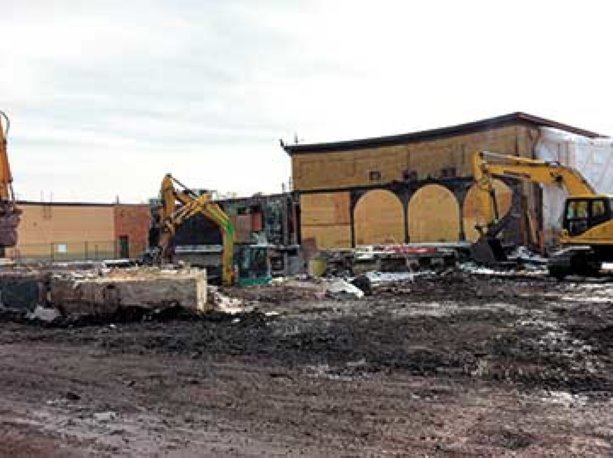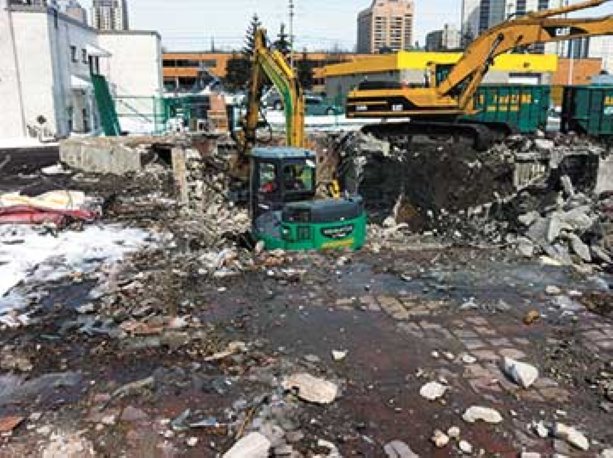Q: How do you restore a Victorian railroad roundhouse that’s been converted to a restaurant? A: You demolish everything that doesn’t look like a roundhouse.
That take on an old riddle accurately describes the approach taken by Creative Property Developments Inc. of London, Ont. toward the London Roundhouse Project — the restoration of an 1887 steam locomotive repair shop. The ultimate goal of the project is to repurpose the restored building as high-tech office space, then construct additional buildings radially around it in a style reflecting the Victorian hub.
“The roundhouse was actually a latent discovery,” says Patrick Ambrogio, vice-president of Creative Property Developments, which has amassed significant property holdings in London’s own SoHo area (south of Horton Street and north of the Thames River).
“We had purchased the building that was the home of the Great West Steak House, which had closed in 2006, with no particular idea of what to do with it.”
The 500-seat restaurant had been left in the same state as the day it closed, replete with table settings, salt shakers and a questionable 1970s aesthetic. Floors had been raised and ceilings lowered to create a “multi-level” dining experience, with some of the cozier spaces only eight feet high from floor to ceiling.
“The people who took us through the building didn’t even know how to turn on the lights,” says Ambrogio.
“We went through with flashlights like we were walking through the Titanic. Everywhere we turned there was more and more stuff, crawlspaces and trap doors.”
The developer hired local contractor Brent-Reg Construction to begin undertaking selective interior demolition in 20-by-20-foot sections, with an eye to seeing what should be preserved.
“What was eventually revealed was unbelievable,” says Ambrogio. “We found the ceiling of an industrial Victorian roundhouse, with 20- to 26-foot ceilings and gorgeous beam latticework that formed a perfect radial pattern. People have walked in and say it’s like being inside a cathedral.”
Discovering the perimeter of the original building, the developer began to carefully demolish and remove about 10,000 square feet of the building’s footprint to reveal the 5,500-square-foot roundhouse. Exterior demolition work was contracted to Artscrushing & Recycling.
“We were conducting micro-demolition in the interior simultaneously with macro-demolition on the exterior,” says Ambrogio.
The demolition turned into a journey through the history of the site. Demolition crews removed kitchens and patios and found artifacts such as horseshoes, railroad spikes and even vintage train schedules stuffed into the ceiling. In the past, the building had also housed a fruit wholesaler and the City Scavenger Department, an early 20th-century material recycling facility.
“Some of the floors had been raised in the 1920s to load and unload fruit trucks,” says Ambrogio. “However, where we carefully removed the concrete that had been poured around the support columns, we saw that some of them had sustained damage from contact with the concrete.”
In other cases, columns had been moved to accommodate the restaurant’s salad bar and cantilevered to provide support. Timber specialists replaced all damaged timber with the same type of wood, and painstakingly moved displaced columns to their original locations.
Bricks were also removed from the spaces where windows used to be, letting natural light into the structure from above for the first time in the better part of a century.
While every effort is being made to strip the building back to authentic 1880s glory, Ambrogio notes that it will be outfitted with the latest high-tech amenities, including fibre optic cables. The development has already announced three high-tech companies—rTraction Canada, Atmos Marketing and Nielsen IT Consulting Inc.—as tenants who plan to move in at the building’s scheduled opening on June 30.
“The railroad was the superhighway of its time and there’s some symmetry and poetry in housing high-tech digital tenants who work with the information superhighway of this era,” says Ambrogio. “Selective demolition and repurposing done right provide a rich context to developments such as the London Roundhouse.”




Recent Comments
comments for this post are closed